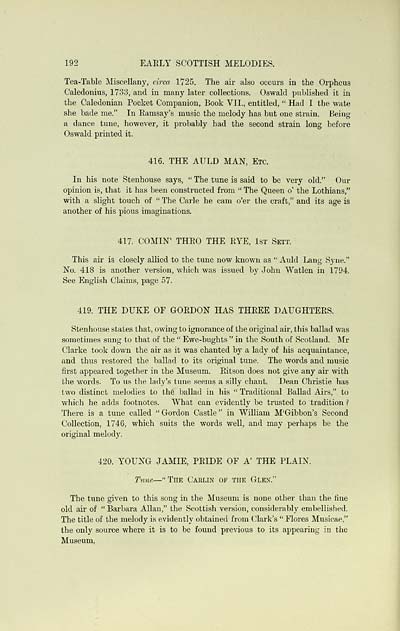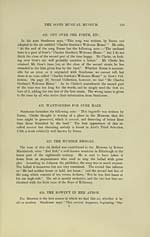Glen Collection of printed music > Printed text > Early Scottish melodies
(214) Page 192 - Auld man
Download files
Complete book:
Individual page:
Thumbnail gallery: Grid view | List view

192 EARLY SCOTTISH MELODIES.
Tea-Table Miscellany, circa 1725. The air also occurs in the Orpheus
Caledonius, 1733, and in many later collections. Oswald published it in
the Caledonian Pocket Companion, Book VII., entitled, " Had I the wate
she bade me." In Ramsay's music the melody has but one strain. Being
a dance tune, however, it probably had the second strain long before
Oswald printed it.
416. THE AULD MAN, Etc.
In his note Stenhouse says, " The tune is said to be very old." Our
opinion is, that it has been constructed from " The Queen o' the Lothians,"
with a slight touch of " The Carle he cam o'er the craft," and its age is
another of his pious imaginations.
417. COMIN' THRO THE RYE, 1st Sett.
This air is closely allied to the tune now known as " Auld Lang Syne."
No. 418 is another version, which was issued by John Watlen in 1794.
See English Claims, page 57.
419. THE DUKE OF GORDON HAS THREE DAUGHTERS.
Stenhouse states that, owing to ignorance of the original air, this ballad was
sometimes sung to that of the " Ewe-bughts " in the South of Scotland. Mr
Clarke took down the air as it was chanted by a lady of his acquaintance,
and thus restored the ballad to its original tune. The words and music
first appeared together in the Museum. Ritson does not give any air with
the words. To us the lady's tune seems a silly chant. Dean Christie has
two distinct melodies to the ballad in his " Traditional Ballad Airs," to
which he adds footnotes. "What can evidently be trusted to tradition ?
There is a tune called " Gordon Castle " in William M'Gibbon's Second
Collection, 1746, which suits the words well, and may perhaps be the
original melody.
420. YOUNG JAMIE, PRIDE OF A' THE PLAIN.
Tune — "The Caklin of the Glen."
The tune given to this song in the Museum is none other than the fine
old air of " Barbara Allan," the Scottish version, considerably embellished.
The title of the melody is evidently obtained from Clark's " Flores Musicae,"
the only source where it is to be found previous to its appearing in the
Museum.
Tea-Table Miscellany, circa 1725. The air also occurs in the Orpheus
Caledonius, 1733, and in many later collections. Oswald published it in
the Caledonian Pocket Companion, Book VII., entitled, " Had I the wate
she bade me." In Ramsay's music the melody has but one strain. Being
a dance tune, however, it probably had the second strain long before
Oswald printed it.
416. THE AULD MAN, Etc.
In his note Stenhouse says, " The tune is said to be very old." Our
opinion is, that it has been constructed from " The Queen o' the Lothians,"
with a slight touch of " The Carle he cam o'er the craft," and its age is
another of his pious imaginations.
417. COMIN' THRO THE RYE, 1st Sett.
This air is closely allied to the tune now known as " Auld Lang Syne."
No. 418 is another version, which was issued by John Watlen in 1794.
See English Claims, page 57.
419. THE DUKE OF GORDON HAS THREE DAUGHTERS.
Stenhouse states that, owing to ignorance of the original air, this ballad was
sometimes sung to that of the " Ewe-bughts " in the South of Scotland. Mr
Clarke took down the air as it was chanted by a lady of his acquaintance,
and thus restored the ballad to its original tune. The words and music
first appeared together in the Museum. Ritson does not give any air with
the words. To us the lady's tune seems a silly chant. Dean Christie has
two distinct melodies to the ballad in his " Traditional Ballad Airs," to
which he adds footnotes. "What can evidently be trusted to tradition ?
There is a tune called " Gordon Castle " in William M'Gibbon's Second
Collection, 1746, which suits the words well, and may perhaps be the
original melody.
420. YOUNG JAMIE, PRIDE OF A' THE PLAIN.
Tune — "The Caklin of the Glen."
The tune given to this song in the Museum is none other than the fine
old air of " Barbara Allan," the Scottish version, considerably embellished.
The title of the melody is evidently obtained from Clark's " Flores Musicae,"
the only source where it is to be found previous to its appearing in the
Museum.
Set display mode to: Large image | Transcription
Images and transcriptions on this page, including medium image downloads, may be used under the Creative Commons Attribution 4.0 International Licence unless otherwise stated. ![]()
| Special collections of printed music > Glen Collection of printed music > Printed text > Early Scottish melodies > (214) Page 192 - Auld man |
|---|
| Permanent URL | https://digital.nls.uk/91350142 |
|---|---|
| Description | Also: Comin' thro the rye. Also: The Duke of Gordon has three daughters. Also: Young Jamie, pride of a' the plain |
| Description | Scottish songs and music of the 18th and early 19th centuries, including music for the Highland bagpipe. These are selected items from the collection of John Glen (1833 to 1904). Also includes a few manuscripts, some treatises, and other books on the subject. |
|---|
| Description | The Glen Collection and the Inglis Collection represent mainly 18th and 19th century Scottish music, including Scottish songs. The collections of Berlioz and Verdi collected by bibliographer Cecil Hopkinson contain contemporary and later editions of the works of the two composers Berlioz and Verdi. |
|---|

